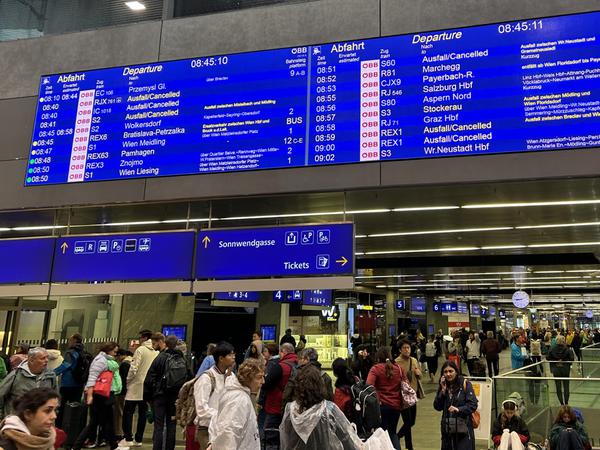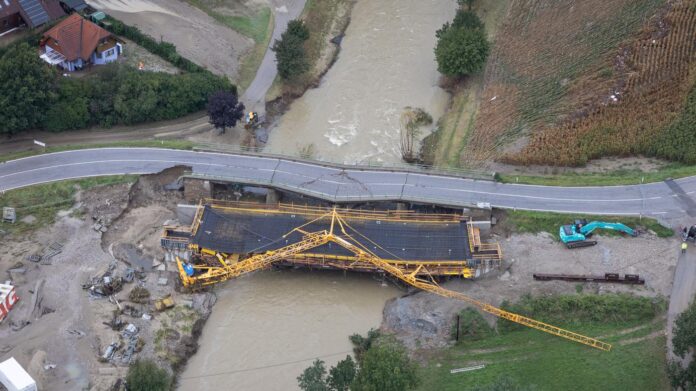On Sunday, many travellers at Vienna’s train stations received the news: Nothing is running anymore. enormous heavy rain The Austrian Federal Railways (ÖBB) cancelled all train connections from Austria’s capital to the west, leaving thousands of travellers stranded.
The situation changed only slightly on Monday. Travel to the west to Linz, as well as to the south to Styria and Carinthia and to Hungary was not possible by train from Vienna. And the ÖBB is asking people nationwide to refrain from non-essential travel until September 19. Because of the flood disaster, especially in Lower Austria around Vienna around 40 routes interrupted.
This also affects train traffic between Germany and Austria: The ICEs that normally travel from Nuremberg to Vienna end in Passau. And the Railjets that normally travel between Munich and Vienna only go as far as Salzburg. Anyone who still wants to travel to Vienna will have to make do with replacement buses from Linz at the latest, provided the road conditions allow it.
No restrictions on German rail traffic
Freight trains to Lower Austria, Hungary, Slovakia and southeastern Europe are also unable to travel. Deutsche Bahn’s transport subsidiary, DB Cargo, is relieved that the ÖBB managed to reopen at least the Tauern route between Salzburg and Klagenfurt on Monday. Many freight trains travel to northern Italy and the Balkans via the Alpine crossing. It was impassable after heavy snowfall and eight fallen trees.

© dpa/Ernst Weiss
Deutsche Bahn was less affected by the floods in the neighboring countries of the Czech Republic and Poland on Monday. Cross-border train traffic there has so far been running as planned. However, DB Cargo is affected by the fact that no trains can run between southern Poland, the Czech Republic and Slovakia.
In Germany, there are no road closures due to flooding or heavy rain. In Saxony, the current flood developmentssays a spokeswoman for Deutsche Bahn. The focus here is on the Elbe valley, through which the Dresden-Prague train line runs. The water level in Dresden is currently at 5.60 meters. The flood peak there is expected to be just over six meters on Wednesday morning. A closure of the train line through the Elbe valley is not foreseeable at the moment.
The railway spokeswoman said that the weather situation in the south and southeast was also being continuously monitored, using various forecasting systems. “Our focus is on making any routes damaged by storms passable again as quickly as possible.” To this end, personnel resources, technology and repair vehicles were kept on standby as a precautionary measure.
Closed motorway in Austria
The ADAC urgently warns drivers not to drive through floodwater. “The actual depth of the water is often difficult to estimate, and obstacles or road erosion in the water cannot be seen,” explains the automobile club. Even at moderate water levels, the vehicle could break down or be swept away by the masses of water because the tires lose their grip on the road.
The actual water depth is often difficult to estimate; obstacles or road erosion in the water cannot be seen.
The ADAC warns against driving through flood water
According to the ADAC, road closures due to flooding are particularly common in Austria, the Czech Republic and Poland, but traffic disruptions are also possible in southern Bavaria and Saxony.
The motorway between St. Pölten and Vienna is currently closed in Austria. The secondary road network there is also “already flooded in large parts,” warns the Austrian motorway company Asfinag. Other motorways in Austria can only be used to a limited extent, and further closures are possible. Drivers can obtain further information about route closures online at the Austrian ADAC counterpart ÖAMTC.
In the Czech Republic, a flood warning is in effect for 220 places along the Oder, Opava and Chrudimka rivers. In towns such as Jesenik and Opava, streets have become raging floodwaters.
Problems for supply chains
In Poland, the situation in Silesia is considered critical in many places. Prime Minister Donald Tusk wants to declare a state of emergency. Slovakia and Hungary, with the capitals Bratislava and Budapest, as well as Romania are also affected. “Travellers should currently avoid unnecessary journeys in the worst-affected regions,” recommends the ADAC.
The logistics industry is currently struggling to find a way to transport its goods. “We have massive disruptions to road and rail traffic and to inland waterway transport, particularly on the Danube in Austria, the Czech Republic, Poland and Slovakia,” say industry sources. Many diversions are necessary, which makes transport more expensive.
The industry is expecting major disruptions to supply chains. This will also affect many German companies, as all affected countries are heavily involved in the production processes due to the division of labor. The crucial question now is how quickly the infrastructure can be restored.
